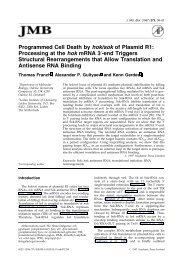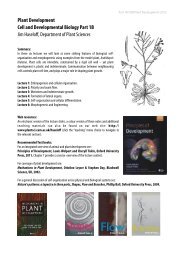Auxin: A major regulator of organogenesis - Department of Plant ...
Auxin: A major regulator of organogenesis - Department of Plant ...
Auxin: A major regulator of organogenesis - Department of Plant ...
Create successful ePaper yourself
Turn your PDF publications into a flip-book with our unique Google optimized e-Paper software.
Polar auxin transport is a highly regulated mechanism,<br />
although the molecular basis <strong>of</strong> PIN localization within the<br />
cell remains poorly understood. One <strong>of</strong> the most characterized<br />
<strong>regulator</strong>s is the PINOID (PID) serine–threonine<br />
protein kinase, identified on the basis <strong>of</strong> the pin-like<br />
phenotype <strong>of</strong> the Arabidopsis pid mutants [43–45]. The<br />
analysis <strong>of</strong> PIN localization in the presence or absence <strong>of</strong><br />
PID provided insight in its role. At the shoot apex, PID loss<br />
<strong>of</strong> function leads to an apical-to-basal shift in PIN1 polarity<br />
[46]. These results indicate that PID regulates polar auxin<br />
transport via a direct control <strong>of</strong> PIN localization. More<br />
recently it was shown that this involves the direct<br />
phosphorylation <strong>of</strong> PIN itself by PID [47]; for detailed<br />
reviews on polar auxin transport [31,32,48].<br />
As briefly described above, the identification <strong>of</strong> the<br />
auxin efflux carrier PIN1 points to a role for auxin in<br />
<strong>organogenesis</strong> at the SAM. PIN1 gene expression is<br />
upregulated in the peripheral zone <strong>of</strong> the SAM at very<br />
early stages <strong>of</strong> <strong>organogenesis</strong>, even before the incipient<br />
primordium outgrowth has started: so far this is one <strong>of</strong> the<br />
earliest markers for organ formation [12,49].<br />
4. <strong>Auxin</strong> and phyllotaxis<br />
Inhibition <strong>of</strong> polar auxin transport, either by NPA or by<br />
mutations in PIN1 or PID, stops organ initiation at the<br />
flanks <strong>of</strong> the SAM but does not affect its other functions: it<br />
results in the formation <strong>of</strong> a naked vegetative or<br />
inflorescence stem [36,43,49,50] (Fig. 3). Exogenous<br />
microapplication <strong>of</strong> IAA to the apex <strong>of</strong> these naked stems<br />
restores organ initiation, showing that auxin is necessary<br />
and sufficient for inducing <strong>organogenesis</strong>. Another striking<br />
result is that organ initiation always takes place at the<br />
meristem flank, whether the IAA is applied to the<br />
peripheral zone or on the meristem summit [50] (Fig. 3).<br />
I. Bohn-Courseau / C. R. Biologies 333 (2010) 290–296 293<br />
This suggests that the cells at the flank <strong>of</strong> the peripheral<br />
zone are competent to react to auxin, whereas cells at the<br />
central zone on top <strong>of</strong> the meristematic dome are not.<br />
Moreover, in the pin1 mutant, the two early markers <strong>of</strong><br />
organ initiation LFY and ANT and the boundary marker<br />
CUC2 are co-expressed in the whole meristem periphery,<br />
suggesting that these competent cells have a hybrid organ/<br />
boundary identity. It is subsequently the amount <strong>of</strong> auxin<br />
applied that will decide whether or not a cell adopts organ<br />
or boundary identity [49]. If we interpret these results in<br />
the context <strong>of</strong> a wild type, a picture emerges, where local<br />
auxin distribution set up by polar auxin transport at the<br />
meristem periphery controls organ positioning and<br />
separation. In the next paragraphs we will further discuss<br />
what controls auxin distribution at meristem flanks.<br />
Application <strong>of</strong> synthetic auxins as 2,4-D (2,4-dichlorophenoxyacetic<br />
acid) and NAA (naphthalene-1-acetic acid)<br />
at naked meristem flanks also provokes organ initiation<br />
but the primordia are ring-shaped [51]. These synthetic<br />
auxins have different properties regarding the polar auxin<br />
transport machinery: NAA does not need the influx carrier<br />
to enter into cells and 2,4-D does not use the efflux carrier<br />
[52]. The severely compromised localization and delimitation<br />
<strong>of</strong> primordia induced by those synthetic auxins<br />
confirm the importance <strong>of</strong> auxin local distribution for<br />
phyllotaxis and reveal the active implication <strong>of</strong> influx and<br />
efflux carriers in setting up local auxin gradients at the<br />
meristem periphery.<br />
Powerful microscopic tools permit to visualize precise<br />
PIN1 localization in the meristem, either by immunolocalization<br />
with a PIN1 antibody or with the pPIN1::PIN1-GFP<br />
reporter gene. PIN1 is located at anticlinal sides <strong>of</strong> L1 cells<br />
and is also expressed in L2 and vascular tissues [53]. At<br />
presumptive sites <strong>of</strong> organ initiation, PIN1 is directed<br />
towards the initium center where it is strongly expressed<br />
Fig. 3. Importance <strong>of</strong> polar auxin transport in the shoot apical meristem for <strong>organogenesis</strong>. A. Arabidopsis wilt-type plant. B. Arabidopsis pin1 mutant; the<br />
stem has no cauline leaf, lateral branche and flower. C. Scanning electron micrograph <strong>of</strong> a pin1 inflorescence apex. The meristem is completely naked<br />
compared with a wild type SAM (see Fig. 1 A). Bar = 200 mm. D. Microapplication <strong>of</strong> IAA (1 mM, paste on right) at the flank <strong>of</strong> the SAM induces the initiation<br />
<strong>of</strong> a flower (result 4 days after treatment). Bar = 100 mm. A to C: from [49]. D: from [50].





